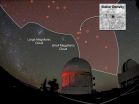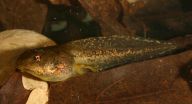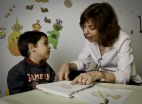Satellite galaxies are small celestial objects that orbit larger galaxies, such as our own Milky Way. Dwarf galaxies can be found with fewer than 1,000 stars, in contrast to the Milky Way, an average-size galaxy containing billions of stars. Scientists have predicted that larger galaxies are built from smaller galaxies, which are thought to be especially rich in dark matter, the substance that makes up about 25 percent of the total matter and energy in the universe. Dwarf satellite galaxies, therefore, are considered key to understanding dark matter and the process by which larger galaxies form.
The main goal of the Dark Energy Survey (DES), as its name suggests, is to better understand the nature of dark energy, the mysterious stuff that makes up about 70 percent of the matter and energy in the universe. Scientists believe that dark energy is the key to understanding why the expansion of the universe is speeding up. To carry out its dark energy mission, DES takes snapshots of hundreds of millions of distant galaxies. However, some of the DES images also contain stars in dwarf galaxies much closer to the Milky Way. The same data can therefore be used to probe both dark energy, which scientists think is driving galaxies apart, and dark matter, which is thought to hold galaxies together.
Scientists can only see the faintest dwarf galaxies when they are nearby, and had previously only found a few of them. If these new discoveries are representative of the entire sky, there could be many more galaxies hiding in our cosmic neighborhood.
"Just this year, more than 20 of these dwarf satellite galaxy candidates have been spotted, with 17 of those found in Dark Energy Survey data," said Alex Drlica-Wagner of the U.S. Department of Energy's (DOE) Fermi National Accelerator Laboratory, one of the leaders of the DES analysis. "We've nearly doubled the number of these objects we know about in just one year, which is remarkable."
In March, researchers with the Dark Energy Survey and an independent team from the University of Cambridge jointly announced the discovery of nine of these objects in snapshots taken by the Dark Energy Camera, the extraordinary instrument at the heart of the DES, an experiment funded by the DOE, the National Science Foundation and other funding agencies. Two of those have been confirmed as dwarf satellite galaxies so far.
Prior to 2015, scientists had located only about two dozen such galaxies around the Milky Way.
"DES is finding galaxies so faint that they would have been very difficult to recognize in previous surveys," said Keith Bechtol of the University of Wisconsin-Madison. "The discovery of so many new galaxy candidates in one-eighth of the sky could mean there are more to find around the Milky Way."
The closest of these newly discovered objects is about 80,000 light-years away, and the furthest roughly 700,000 light-years away. These objects are, on average, around a billion times dimmer than the Milky Way and a million times less massive. The faintest of the new dwarf galaxy candidates has about 500 stars.
Most of the newly discovered objects are in the southern half of the DES survey area, in close proximity to the Large Magellanic Cloud and the Small Magellanic Cloud. These are the two largest satellite galaxies associated with the Milky Way, about 158,000 light-years and 208,000 light-years away, respectively. It is possible that many of these new objects could be satellite galaxies of these larger satellite galaxies, which would be a discovery by itself.
"That result would be fascinating," said Risa Wechsler of DOE's SLAC National Accelerator Laboratory. "Satellites of satellites are predicted by our models of dark matter. Either we are seeing these types of systems for the first time, or there is something we don't understand about how these satellite galaxies are distributed in the sky."
Since dwarf galaxies are thought to be made mostly of dark matter, with very few stars, they are excellent targets to explore the properties of dark matter. Further analysis will confirm whether these new objects are indeed dwarf satellite galaxies and whether signs of dark matter can be detected from them.
The 17 dwarf satellite galaxy candidates were discovered in the first two years of data collected by the Dark Energy Survey, a five-year effort to photograph a portion of the southern sky in unprecedented detail. Scientists have now had a first look at most of the survey area, but data from the next three years of the survey will likely allow them to find objects that are even fainter, more diffuse or farther away. The third survey season has just begun.
"This exciting discovery is the product of a strong collaborative effort from the entire DES team," said Basilio Santiago, a DES Milky Way Science Working Group coordinator and a member of the DES-Brazil Consortium. "We've only just begun our probe of the cosmos, and we're looking forward to more exciting discoveries in the coming years."
INFORMATION:
The Dark Energy Survey is a collaboration of more than 300 scientists from 25 institutions in six countries. Its primary instrument, the 570-megapixel Dark Energy Camera, is mounted on the 4-meter Blanco telescope at the National Optical Astronomy Observatory's Cerro Tololo Inter-American Observatory in Chile, and its data is processed at the National Center for Supercomputing Applications at the University of Illinois at Urbana-Champaign.
Funding for the DES Projects has been provided by the U.S. Department of Energy Office of Science, the U.S. National Science Foundation, the Ministry of Science and Education of Spain, the Science and Technology Facilities Council of the United Kingdom, the Higher Education Funding Council for England, ETH Zurich for Switzerland, the National Center for Supercomputing Applications at the University of Illinois at Urbana-Champaign, the Kavli Institute of Cosmological Physics at the University of Chicago, Financiadora de Estudos e Projetos, Fundação Carlos Chagas Filho de Amparo à Pesquisa do Estado do Rio de Janeiro, Conselho Nacional de Desenvolvimento Científico e Tecnológico and the Ministério da Ciência e Tecnologia, the Deutsche Forschungsgemeinschaft and the collaborating institutions in the Dark Energy Survey, which can be found at http://www.darkenergysurvey.org/collaboration.
Fermilab is America's premier national laboratory for particle physics and accelerator research. A U.S. Department of Energy Office of Science laboratory, Fermilab is located near Chicago, Illinois, and operated under contract by the Fermi Research Alliance LLC. Visit Fermilab's website at http://www.fnal.gov and follow us on Twitter at @Fermilab.
The DOE Office of Science is the single largest supporter of basic research in the physical sciences in the United States and is working to address some of the most pressing challenges of our time. For more information, please visit science.energy.gov.




